

![]()

Abergavenny, Caerleon, Chepstow,
Newport & Little Mill:
Lock-ups, Gaols & Boys Reformatory
ABERGAVENNY
THE LOCK-UP HOUSE (in Monk Street, near the Churchyard)
1806 Prison Inspectors Report on the Abergavenny Gaol
Keeper: William Thomas; Salary: None
Consists of 2 rooms; that for prisoners is ten feet by four, with arched roof; wood bedstead with straw; lighted by an aperture in the wall, and a grating of eight inches square in the door, through which they receive their provisions.
Numbers of Prisoners:
1802 - 1806: None recorded
1813-1814: Two Hundred "French Prisoners of War" in Abergavenny!
After the Napoleonic Wars, Abergavenny became one of the many Depots for French Prisoners of War. At one time they numbered upwards of two hundred. They consisted of soldiers and sailors, a few of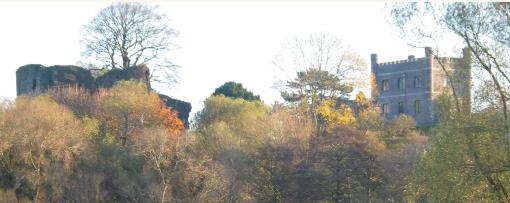 them being officers. The rank and file are believed to have been lodged in a room at the old Castle, and in several large barns, whilst the officers, who were on parole, occupied private rooms in different parts of the Town. Amongst these prisoners were sufficient Freemasons to establish and work a Lodge, under the appropriate name of "Enfants de Mars et de Neptune." Tradition points to a large room in Monk Street, about 100 yards from the old Priory Church of St. Mary. (The town of Chepstow was another depot for French prisoners)
them being officers. The rank and file are believed to have been lodged in a room at the old Castle, and in several large barns, whilst the officers, who were on parole, occupied private rooms in different parts of the Town. Amongst these prisoners were sufficient Freemasons to establish and work a Lodge, under the appropriate name of "Enfants de Mars et de Neptune." Tradition points to a large room in Monk Street, about 100 yards from the old Priory Church of St. Mary. (The town of Chepstow was another depot for French prisoners)
1843 Prison Inspectors Report on Abergavenny Lock-Up House
This Lock-up House contains four cells for men, measuring seven feet by four feet, and seven feet in height. They receive air through grated openings at the back, through which communications might be made to the prisoners from without, and even instruments conveyed to them with which to effect their escape. The cells contain no beds; straw being laid down for the use of prisoners when confined therein. The only place for the reception of females is the passage leading to the cells of the men, one end of which is widened into a sort of apartment; but it has no door to shut it off from the remainder of the passage, the females, when there are any in confinement, may range freely through the passage and converse with the male prisoners at their doors. The only privy is situated in this passage. The building is very insecure, and escape would not be difficult from any part of it, especially as no Officer resides in or near it. The keys are kept by a policeman, who, being the only officer of that description in the town, is of course frequently absent on other duty, and cannot always be found when required. There are also in the town two watchmen and eight constables, but as they are not responsible for the custody of the prisoners, they are not allowed to have keys of the cells in which prisoners are confined. Persons are liable to be detained here for several days, when remanded for further examination, and the present officer recollects some who have been so detained for a week, and many for three days.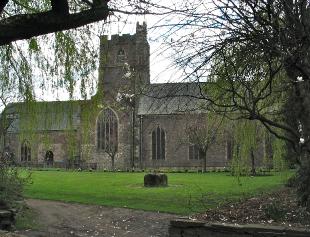
There being no airing-yard, the officer is in the habit of giving exercise to such as have been more than a day in confinement, by taking them into the street and contiguous churchyard in handcuffs. The diet consists of four-pennyworth of bread and a quarter of a pound of cheese daily to each prisoner.
It is of much importance that this very insecure and incommodious building should be replaced by one of greater strength and more extended accommodation, as a very considerable number of persons are occasionally confined in it. The officer informed me that he has known as many as 16 male prisoners confined at the same time, and, - as a confirmation of the observation made above upon its insecurity, it should be added, - that eight of that number broke out in broad daylight.
1847 The "Sanitation of the Town of Abergavenny":
"The Gate", or Lock-up is a small stone building in Monk Street; the Kibby runs directly beneath the pavement. It is close and liable to damp, and the separate cells are much too small, and would exercise a very pernicious effect upon the health of prisoners long confined in them; but as they are seldom tenanted for more than a few days at a time; no ill consequences have hitherto been observed.
1850 Prison Inspectors Report
No change in the dilapidation and filth in which this building is found and the recommendations which had been made for the erection of a place of greater strength and more extended accommodation have not been followed. I have brought the matter under the notice of the Secretary of State. "………. Since the last Report four prisoners have escaped by breaking through a wall. Twice within the month of September last, the building was nearly burnt and prisoners suffocated, by the latter having lighted the straw for the purpose of warming themselves …. As matters exist at present, lucifer-matches and even bladders of spirituous liquors may be passed under the door, or even put through a window into a cell. An instance was related to me at my last inspection, in October last, of a bladder of spirits having been passed under the door on a recent occasion, by which a prisoner was sent dead-drunk to the House of Correction at Usk. …….. The building belongs to the Corporation of Abergavenny, but is chiefly used for the detention of county prisoners, for which purpose a place of confinement in that locality is very necessary, on account of the near neighbourhood of the iron-works." …….. The fifth and dampness of the cells were even more revolting than at my previous visits.
………………
CAERLEON COMMON GAOL
1576 The Court Roll of this date mentions the Assize taking place in Carlyon on the Tuesday after Michaelmas (2-3 October) 1576 and that prisoners were brought from the Common Gaol in that place and that John Hughes was Keeper of the Gaol at that time.
………………
CHEPSTOW
The OLD TOWN GAOL (in the Town Gatehouse at the end of the High Street, next to The George Hotel)
1524: A Charter dated 2nd Dec., 16 Hen. VIII, records that the Earl of Worcester had rebuilt the Town Gate (pictured left), and had given it to the Burgesses of Chepstow for a Prison.
The CHEPSTOW LOCK-UP HOUSE
1850 Prison Inspectors Report
The Lock-Up House of this town is quite as little fitted for its purpose as that of Abergavenny, both from insufficiency of extent and want of security. It consists of a single cell, 12 feet by 9 feet, whose only furniture is a wooden bedstead, the iron legs of which 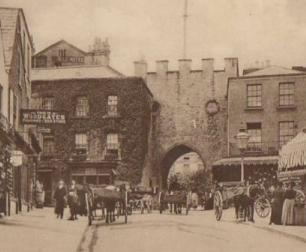 might be used as weapons to effect escape. No bedding is allowed for the prisoners, and, although the place is very damp and cold, they are not even furnished with straw. The wall, being only one brick in thickness, has often been broken through by prisoners confined in the cell. The building being situated in the worst part of the town - a part inhabited almost exclusively by vagrants and other bad characters - attempts at rescue are very common, and, from there being no officer resident on the spot, are frequently successful. Among many instances of this kind which were related to me was one which, the lock having been picked from the outside in the middle of the day, a man was liberated who was under remand for having committed a robbery near Newport; and another, in which a man confined under charge of cattle-stealing let himself out in the middle of the day, and has never since been heard of, although a reward was offered for his recapture. These instances suffice to show the insecurity of the building.
might be used as weapons to effect escape. No bedding is allowed for the prisoners, and, although the place is very damp and cold, they are not even furnished with straw. The wall, being only one brick in thickness, has often been broken through by prisoners confined in the cell. The building being situated in the worst part of the town - a part inhabited almost exclusively by vagrants and other bad characters - attempts at rescue are very common, and, from there being no officer resident on the spot, are frequently successful. Among many instances of this kind which were related to me was one which, the lock having been picked from the outside in the middle of the day, a man was liberated who was under remand for having committed a robbery near Newport; and another, in which a man confined under charge of cattle-stealing let himself out in the middle of the day, and has never since been heard of, although a reward was offered for his recapture. These instances suffice to show the insecurity of the building.
With references to the want of accommodation, it needs only to be remarked that, as there is only one cell, the female prisoners, when there are any in custody at the same time as males, are either allowed to depart, or, if the charges against them are serious, are kept at public-houses through the night, under the care of constables, who, not being stipendiary officers, may be supposed not to be very vigilant. As the policemen live in a distant quarter of the town, it cannot be expected that, in addition to their other duties, they should watch the Lock-Up House, or take any charge of the women at the public-houses.
At the 1850 Michaelmas Sessions the state of the County's Lock-Up Houses was discussed and it was of the opinion of the Bench that, "the financial position of the county would not admit of the the whole of the lock-up houses of the ten divisions of the county being placed in repair, which would be the necessary consequence if one or two were done. The heavy debt lying upon the county for the House of Correction and the Lunatic Asylum, the Court does not think fit, at present, to incur the expense of a new Lock-Up House in those divisions [Chepstow & Abergavenny], which would lead to their establishment in ten other divisions of the county."
1850 Report:
Nothing has changed since the last recommendations were made. Thus has it to be determined that the abominations acknowledged to exist in two of the lock-up houses of the county are to be perpetuated, lest their abatement should be urged as a ground for inquiry into the condition of other county establishments of a like nature.
………………
NEWPORT
TOWN GAOL & LOCK-UPS
One of the original Lock-ups was in the old West Gate which straddled the foot of Stow Hill where the Westgate Hotel now stands. The old West Gate was demolished at the end of the 1700s having stood for 450 years and before it became a prison was used as an office for the collection of Custom Duty.
1792 Report on Newport Town Gaol (The West Gate):
Two rooms; one below, the other over the Gateway; out of repair; no court; no sewer; no water.
Numbers of Prisoners:
1782 Oct 24 - no prisoners
There was also another Lock-Up in Carpenters Arms Lane, off the top of High Street, which was closed in 1840.
1806 Mill Street Gaol was completed (known locally as the "Clock House")
1831, 25 March
Letter from the Town Clerk's Office, Newport
No Expenses have been incurred within the Borough of Newport, since the year 1800, in building any Gaol or House of Correction. The Expense of cleaning and repairing the Town Prison has been defrayed out of the Poor's Rates, and we have no means of preparing the Account required. (signed) Prothero & Phillips
1835 Report of Commissioners states - There is a Gaol but, as the magistrates are entitled by the charter to commit to the County Gaol, it is now only used as a Lock-up House.
1850 Prison Inspectors Report
NEWPORT LOCK-UP HOUSE and POLICE STATION [in Dock Street, adjacent to the Town Hall, Library and Fire Station - approx. where Newport Museum & Library now stand in John Frost Square]
This place of detention has been recently erected, and is in very good repair in every respect. Three officers, one of whom is married, reside on the premises. It has a good communication with the courts, so that the prisoners can be conveyed to and from the latter without passing any public thoroughfare. The accommodation for male prisoners consists of one large cell on the ground-floor, for the reception of night-charges, and, on the floor above, a day-room and 4 sleeping cells, one of which is, however, used as a store-room. There is a large bed in each cell; the windows are not glazed, but there are shutters to keep out the cold; each cell has a water-closet, with a good supply of waters, under command of the officer without. The doors of the cells are pierced with inspection-holes. The females are placed in a separate building; they have one day-room and two sleeping cells. The room for receiving charges, and the other necessary parts of a police-station, are placed on the same side with them. The Diet allowed to prisoners seems to me greatly in excess of what is needful for the preservation of their health, the daily rations being: 2lbs of bread; 1.2lb. of cheese; 2 quarts of coffee. Few of the prisoners, of course, enjoy this good fare for more than a single day, but it may be continued longer in cases remanded for further examination. With a superfluous regard to the taste of the prisoners under the latter circumstances, however, their food after the first few days is varied, by the substitution of tea for the coffee, and of 1/4lb. of butter for the cheese.
1878 When the notorious "Llangibby Murderer", Joseph Garcia was arrested at Newport Railway Station on the night of 18th July 1878 - he was detained in the Newport County Police Cell which was located under the "Victoria Hall Theatre" in Bridge Street. [This building burned down eighteen years later and was rebuilt as "The Lyceum Theatre"]
1891 Kellys Directory:
The TOWN HALL, Commercial Street, opened in 1885. it has one frontage on Commercial Street, another to Dock Street: in the central portion is the Police Court with the Assembly Room over it; on the Dock Street side is the Police Station, with the chief constable's office and twelve cells and an attendant's dwelling. The COUNTY COUNCIL OFFICES, in Pentonville, erected in 1885-6 is a plain stone building, comprising offices for the Chairman, Clerk and Surveyor, with a Police Station attached, having cells and living quarters for a sergeant and 3 constables; at rear of which is the Court House, where Petty Sessions are held every Saturday at 12 noon. There are also Police Branch Stations at Pillgwenlly and Maindee.
………………
MAMHILAD
THE MONMOUTHSHIRE REFORMATORY,
Situated at Little Mill, Mamhilad, this Boys' Reformatory comprised a school and a small farm; the estate was purchased by voluntary subscription & vested trustees & the whole expense of the necessary buildings was covered by subscriptions; in February, 1859, it was certified by Government & the school was opened for boys, who are sentenced by magistrates, first to a short term of imprisonment & then to a term of from two to five years of compulsory detention in a reformatory; a new school room & superintendent's room, with dormitory over, was added in 1881.
The Usk Prisoners Receiving books for the years 1871-76 list a number of boys, ages varying between 11 - 14 years who, after serving a short term of imprisonment (sometimes with hard labour) were then transferred for detention at Little Mill and various other county reformatories.
When the School opened in 1859 the first boy admitted was 10 years old Michael Collins of 22 Canal Parade, Newport. He had been convicted of stealing coal, sentenced for 2 weeks imprisonment and then 5 years Reform School. He had been previously convicted on Jan 6th 1857 (age 8) for stealing coal with his father. His father was ordered by the Magistrates to pay 1s. 3d. per week towards his upkeep at the school. His character: Sharp, idle, but ignorant, goes about vessels begging scraps off sailors. His 1864 School Report reads: After remaining 4.1/2 years in the school, he was placed on license under a captain of a ship bound for the Mediterranean, he returned from the voyage with a double character: "V.G." and has since been placed by the Managers in a ship-yard on license, till the expiration of his term. Unfortunately Michael Collins good behaviour was not to last. By Jan 23 1871, age 21, he was convicted of stealing a fur cap and sentence to 3 months hard labour. See his photograph (right) taken from the Usk Prison Book Q/CG38.
In 1891 the Reformatory held 40 boys and in this year the staff were listed in Kelly's Monmouthshire Directory as:
Frederick G.W. Chalklen, Hon, Sec;
Rev. Stephen Cattley Baker B.A., Usk, Hon. Chaplain;
Donald Fludyer Boulton, Usk, Surgeon;
Edwin Bilcliffe, Superintendent & Farm Bailiff;
Melton Jones, labour master;
Charles Merrick, schoolmaster;
Mrs. Bilcliffe, Matron.
The Gwent Archives hold various registers for The Little Mill Reformatory 1859-1922 Ref:Q/MR/9 - Q/MR/14
(We intend to transcribe these for our searchable database)
![]()
All images unless otherwise credited are © MonGenes and may not be reproduced without permission
© MonGenes 2013

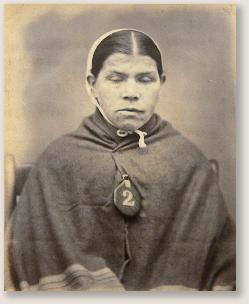
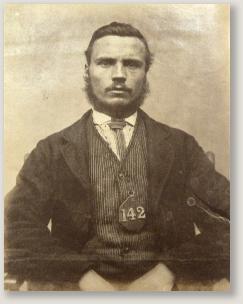
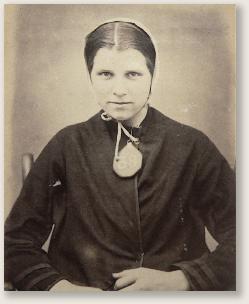
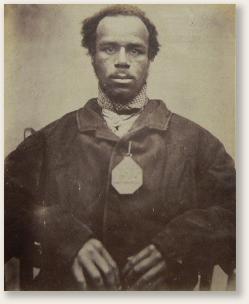

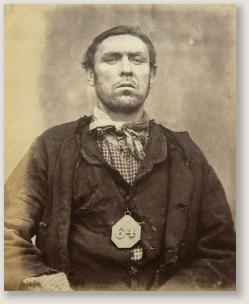
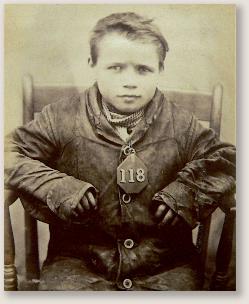
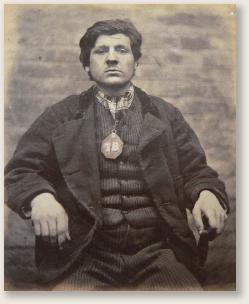

Prisoner's photographs are from the Usk Prison Release Books (Ref. Q/CG/38, 39 & 40) at the Gwent Archives. Search our Database for a full transcript of these records

CRIME & PUNISHMENT PAGES
CRIME & PUNISHMENT PAGES



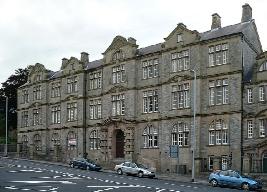 Newport Shire Hall - Old Council Offices, Pentonville
Newport Shire Hall - Old Council Offices, Pentonville